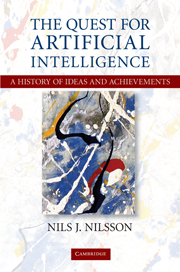Book contents
- Frontmatter
- Contents
- Preface
- PART I BEGINNINGS
- PART II EARLY EXPLORATIONS: 1950S AND 1960S
- PART III EFFLORESCENCE: MID-1960S TO MID-1970S
- PART IV APPLICATIONS AND SPECIALIZATIONS: 1970s TO EARLY 1980s
- PART V “NEW-GENERATION” PROJECT
- 22 The Japanese Create a Stir
- 23 DARPA's Strategic Computing Program
- PART VI ENTR'ACTE
- PART VII THE GROWING ARMAMENTARIUM: FROM THE 1980s ONWARD
- PART VIII MODERN AI: TODAY AND TOMORROW
- Index
- Plate section
23 - DARPA's Strategic Computing Program
Published online by Cambridge University Press: 05 August 2013
- Frontmatter
- Contents
- Preface
- PART I BEGINNINGS
- PART II EARLY EXPLORATIONS: 1950S AND 1960S
- PART III EFFLORESCENCE: MID-1960S TO MID-1970S
- PART IV APPLICATIONS AND SPECIALIZATIONS: 1970s TO EARLY 1980s
- PART V “NEW-GENERATION” PROJECT
- 22 The Japanese Create a Stir
- 23 DARPA's Strategic Computing Program
- PART VI ENTR'ACTE
- PART VII THE GROWING ARMAMENTARIUM: FROM THE 1980s ONWARD
- PART VIII MODERN AI: TODAY AND TOMORROW
- Index
- Plate section
Summary
The Strategic Computing Plan
By the early 1980s expert systems and other AI technologies, such as image and speech understanding and natural language processing, were showing great promise. Also, there was dramatic progress in communications technology, computer networks and architectures, and computer storage and processing technologies. Robert Kahn (1938–; Fig. 23.1), who had become Director of DARPA's Information Processing Techniques Office (IPTO) in 1979, began thinking that DARPA should sponsor a major research and development program that would integrate efforts in all of these areas to create much more powerful computer systems. At the same time, there was concern that the Japanese FGCS program could threaten U.S. leadership in computer technology. With these factors as background, Kahn began planning what would come to be called the “Strategic Computing” (SC) program.
Kahn had been a professor at MIT and an engineer at BBN before he joined DARPA's IPTO as a program manager in late 1972. There he initiated and ran DARPA's internetting program, linking the Arpanet along with the Packet Radio and Packet Satellite Nets to form the first version of today's Internet. He and Vinton Cerf, then at Stanford, collaborated on the development of what was to become the basic architecture of the Internet and its “Transmission Control Protocol” (TCP). (TCP was later modularized and became TCP/IP, with IP standing for Internet Protocol.) Cerf joined DARPA in 1976 and led the internetting program until 1982. For their work, Kahn and Cerf shared the 2004 Turing Award of the Association for Computer Machinery.
- Type
- Chapter
- Information
- The Quest for Artificial Intelligence , pp. 286 - 302Publisher: Cambridge University PressPrint publication year: 2009



